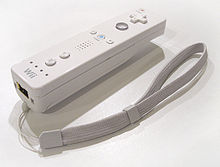- Motion controller
-
A motion controller controls the motion of some object. Frequently motion controllers are implemented using digital computers, but motion controllers can also be implemented with only analog components as well.
Contents
Implementation
Motion controllers require a load (something to be moved), a prime mover (something to cause the load to move), some sensors (to be able to sense the motion and monitor the prime mover), and a controller to provide the intelligence to cause the prime mover to move the load as desired.
Just about everything that is man-made requires motion control during its manufacture, packaging, distribution or use[citation needed].
Benefits
Motion controllers are used to achieve some desired benefit(s) which can include:
- increased position and speed accuracy
- higher speeds
- faster reaction time
- increased production
- smoother movements
- reduction in costs
- integration with other automation
- integration with other processes
- ability to convert desired specifications into motion required to produce a product
- increased information and ability diagnose and troubleshoot
- increased consistency
- improved efficiency
- elimination of hazards to humans or animals
Gaming
Motion controllers using accelerometers are used as controllers for video games, which was publically introduced in 2006 by Nintendo's Wii Remote, which uses accelerometers to detect its approximate orientation and acceleration, and serves an image sensor,[1] so it can be used as a pointing device. It was followed by other similar devices, including the ASUS Eee Stick, Sony's PlayStation Move (which also uses magnetometers to track the Earth's magnetic field and computer vision via the PlayStation Eye to aid in position tracking), and HP's Swing.[2] Other systems use different mechanisms for input, such as Microsoft's Kinect accessory, which uses a combination infrared structured light and computer vision, and the Sixense TrueMotion, which uses a magnetic field to determine position and orientation.
The Sega Activator, based on the Light Harp invented by Assaf Gurner,[3] was released for the Mega Drive (Genesis) in 1993. It could read the player's physical movements and was the first controller to allow full-body motion sensing. However, it was a commercial failure due to its "unwieldiness and inaccuracy".[4] The Atari Mindlink was an early proposed motion controller for the Atari 2600, which measured the movement of the user's eyebrows with a fitted headband.
References
- ^ Castaneda, Karl (2006-05-13). "Nintendo and PixArt Team Up". Nintendo World Report. http://www.nintendoworldreport.com/news/11557. Retrieved 2007-02-24.
- ^ "HP ships Swing motion controller hardware with Pavilion PCs in India". Engadget. http://www.engadget.com/2010/04/24/hp-ships-swing-motion-controller-hardware-with-pavilion-pcs-in-i/. Retrieved 2011-11-01.
- ^ Light Harp at CES 1993. YouTube. http://www.youtube.com/watch?v=YoxsnCiX05k. Retrieved 2010-07-06.
- ^ Horowitz, Ken (2004-08-03). "Top 10 Tuesday: Worst Game Controllers". Sega-16. http://www.sega-16.com/feature_page.php?id=85&title=Genesis%20Accessory%20&%20Peripheral%20Guide. Retrieved 2010-12-04.
Categories:- Computing input devices
Wikimedia Foundation. 2010.

